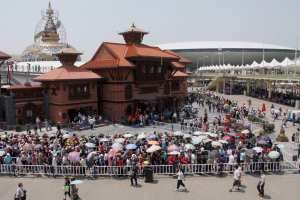|
|


ADVERTISEMENT
Buy Your own advertising
spaces!
.
Download Adobe Acrobat Reader to open [PDF] files.
Recent Visitors
Shanghai’s $58bn Expo and the sums that don’t add up
2010. 7 June
 The authorities have tried to spread visitor numbers throughout the day to reduce queuing at the Shanghai expo. Nick Ut / AP
The authorities have tried to spread visitor numbers throughout the day to reduce queuing at the Shanghai expo. Nick Ut / AP
by Daniel Bardsley
(thenational.ae)
Expo 2010 has a profile in China almost as big as the bill the event has run up.
The six-month exposition on either side of the Huangpu River that runs through China’s business capital has attracted daily coverage in the government-controlled newspapers and television stations.
This is perhaps no surprise given the money the authorities have invested in the project. Local estimates put the cost of developing the expo site and upgrading Shanghai’s infrastructure at as much as US$58 billion (Dh213bn).
But, for all the billions spent on it, so far at least the event is not on track to achieve the 70 million visitor total predicted before it began on May 1.
As of yesterday afternoon, a total of 10,496,400 people had gone through the gates. If repeated for the remainder of the event, this would give a total attendance of slightly above 50 million, echoing the 2008 Olympics, which although generally hailed as a success, were also remembered for empty seats in the stadiums.
The expo, which has the theme of sustainable urban living, features pavilions from most countries in the world, along with displays from China’s various provinces and international organisations. There are also specialist pavilions about urban living across the world and industries, including oil. Among the Gulf countries to have pavilions are the UAE, Qatar, Oman and Saudi Arabia, which is one of China’s most important oil suppliers and has built a vast Imax cinema onsite.
One problem highlighted in the early stages, even on the first day when attendance was about 200,000 – about half the average number of daily visitors needed to reach the 70 million target – has been long queues at the pavilions.
Bala Ramasamy, a professor of economics at the China Europe International Business School in Shanghai, said this may have discouraged visitors early on. In a country where fewer than five per cent of people travelled overseas last year, he said he thought that the idea of showing off foreign countries in an expo had not lost its basic appeal, however.
“Possibly the news about long queues [has put people off] and I am sure it’s been circulated on the internet, and the target market are those that would be the internet savvy ones,” he said. “I am sure there’s a lot of [internet] chat saying there are queues.”
Those visiting this month admitted that queuing to enter the most popular pavilions had been a downside.
“It’s very good, but it’s involved waiting a long time,” said Wang Wei, 50, a businessman from Beijing, who had been unable to enter the US, Japanese and Chinese pavilions because of the crowds.
Qi Jian, 21, a student in Shanghai, said in three days of visiting the expo, he failed to visit the Japanese, German and British pavilions because of long queues. Despite this, he expected visitor numbers to grow.
“I think really the expo is popular,” he said. “Almost all the people like to attend. I think most people think the first weeks are not a good time to attend because they think too many people will go through.”
Similarly, Zhang Kun, 19, a student from Henan province, said people had been put off early on because they thought the event would be crowded. Now that the event has been running for several weeks, he said, people were more likely to visit.
To reduce overcrowding, the authorities have tried to spread visitor numbers across the day by offering separate evening tickets, and Mr Zhang was planning to buy one of these.
Suggesting they believed visitor numbers were likely to increase as the event went on, organisers simply said in an e-mailed response to questions that the event still had several months to go.
Indeed their hopes that attendances will increase may be realised. While daily visitor numbers averaged less than 200,000 for the first two weeks, they have since picked up significantly. On May 29, a record for the expo was set, with 503,600 going through the gates. The all-time one-day attendance record was set at Expo 67 in Montreal – 569,000.
The importance of the expo, however, is not whether it reaches 70 million visitors, according to Mr Ramasamy. While the Olympics may not have been a sell-out, it did engender a large amount of “patriotic spirit”.
Likewise, seeing their country has staged an event on the scale of the expo, he said, gave Chinese people “a great degree of hope as to what China can become in the future”.
This optimism, he said, was likely to encourage greater spending by residents, a key aim in the government’s drive to move the economy from one that relies on exports to one fuelled by domestic consumption. “These events to create an influence in terms of raising the local consumption within China.
“An important factor is this idea of consumer confidence. These major events are telecast on television and it does build confidence among the local Chinese.”
dbardsley@thenational.ae
Source: www.thenational.ae


